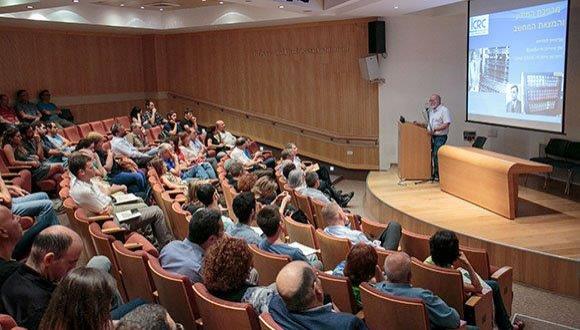סמינר מחלקתי ביה"ס להנדסה מכאנית Ori Gadot and Elad Hahn
School of Mechanical Engineering Seminar
Wednesday, January 25, 2017 at 14:00
Wolfson Building of Mechanical Engineering, Room 206
A UNIVERSAL CONSTRUCTION RULE FOR THE STRUCTURAL SYNTHESIS OF MECHANISMS AND TRUSSES
Elad Hahn
M.Sc. student of Prof. Offer Shai
In the field of structural synthesis of mechanisms, several synthesis methods have been developed using different approaches. One of the more interesting approaches was that of bottom-up construction via the combination of modular structural groups, known as Assur groups. In this thesis, this approach is combined with new graph representations of mechanisms taken from Rigidity theory, capable of representing all the different types of planar and spatial mechanisms. With the strong mathematical base of Rigidity theory, a new synthesis method is proposed based on Assur groups, which are reformulated in terms of graphs and renamed Assur Graphs (AG). The reformulation of Assur Graphs generalizes the use of Assur groups from mechanisms to any type of topological structure, e.g., trusses, molecules and data networks. Using a single Universal Construction Rule, Assur Graphs of different types and of any size are constructed, creating a complete set of building blocks for the synthesis of all feasible structure topologies. The thesis focuses on construction of engineering systems, i.e., mechanisms and trusses. As its name implies, the Universal Construction Rule (UCR) is applicable to mechanisms of all types of joints and links, for planar or spatial motion. This construction method also gives insight on the complexity of a structure for static and kinematic analysis.
The UCR provides two main contributions to the field of structural synthesis. The first is using a single induction step algorithm applicable for all different types of mechanisms and topological structures. This is opposed to other synthesis methods which are limited to only certain types of mechanisms, generally using several synthesis approaches. The second contribution is the development of a coherent method for construction of Assur Graphs of infinite size, which enables the exploitation of some unique engineering properties residing in Assur groups. These unique properties are also mentioned in this thesis.
School of Mechanical Engineering Seminar
Wednesday, January 25, 2017 at 14:00
Wolfson Building of Mechanical Engineering, Room 206
A New Void Growth Micromechanical Damage Model for Materials under Ballistic Impact
Ori Gadot
MSc Student of Prof. Rami Haj-Ali
Composite materials are one of the most widely used materials in the past half century, and yet, accurate predictive modeling of their mechanical behavior has not been fully resolved. Currently, many damage material models are based on phenomenological considerations, microstructural geometrical generalizations, or statistical approaches. Nucleation, growth and coalescence of microcavities are known physical mechanisms occurring during material deformation. These phenomena are the predominant damage mechanisms in both metallic and brittle material models, e.g. the well-known Gurson's void growth model.
Presented herein is a new approach for the characterization of mechanical damage response of porous and non-porous materials. The method is based on a micromechanical model known as the Generalized Method of Cells (GMC). The model considers a simple three-dimensional Repeating Unit Cell (RUC) which includes an embedded initial void that is explicitly recognized as a growing “inclusion”. The mechanical response of the homogenous material is formulated by means of traction and displacement continuities within the RUC. Triple periodicity conditions are also employed as neighboring RUCs. The uniqueness of this model is the addition of evolution equations for the microstructure, i.e. a varying phase geometry dictated by a void growth evolution rule. The progressive void volume ratio (VVR) alters the relations between the material's phases, thus strongly affecting the homogenous material behavior and generating strain-softening type degradation of the mechanical behavior.
For ductile materials, known for their extensive cavity growth, the method uses a plastic strain accumulation evolution technique based on McClintock's rate of void growth.
Additionally, the model uses a void growth type criterion based on the average volumetric strain in order to describe brittle type high-rate fracture behavior. The latter scheme has been implemented as a material model with an explicit finite element (FE) code. Dynamic simulations of a ceramic armor plate under ballistic impact have been carried out. Successful ceramic fracture simulation responses were generated by the new model, such as radial crack progression in the armor plate and conical crack shape development in the impact zone.


